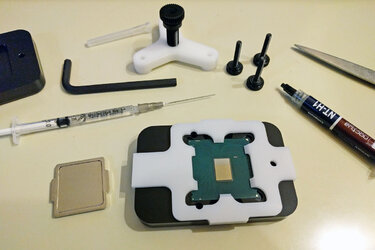- Joined
- Mar 7, 2008
With my cooling woes on one sample of 6700k where there's a large differential between cores, I've decided to delid it and have ordered the Rockit tool. Depending on how that goes I'm tempted to do the other K processors, but I was also thinking of using an i3 as a practice run... before anyone questions if I need to do this, I do. I've observed temperature dependant stability problems once things start going above 80C or so, and know they shouldn't get that hot with the cooling solution and settings used.
Anyway, where I'm undecided is to run topless or not. The safer option seems to be a re-TIM and lid back on, where I hope I will do a better job than Intel did. The other higher risk option is to go topless. I note Aqua Computer make a dedicated shim and wonder if that is sufficient. I further note that due to removing the thickness of the IHS there may be problems with getting a good fitting depending on the cooler.
Anyway, where I'm undecided is to run topless or not. The safer option seems to be a re-TIM and lid back on, where I hope I will do a better job than Intel did. The other higher risk option is to go topless. I note Aqua Computer make a dedicated shim and wonder if that is sufficient. I further note that due to removing the thickness of the IHS there may be problems with getting a good fitting depending on the cooler.
